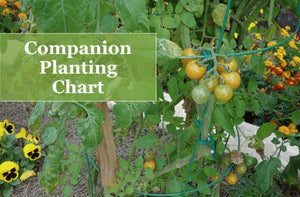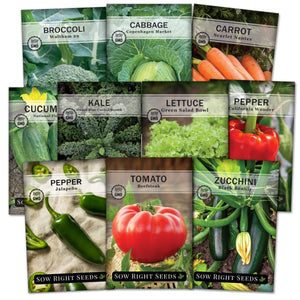How to Save the Seeds from Your Favorite Flowers, Herbs, and Vegetables
Beginner gardeningOnce you start growing plants from seed, it's common to find yourself drawn to the idea of saving seeds from your favorite plants. Perhaps you had an incredibly bright zinnia or a prolific pepper plant and want to duplicate those results next year. Seed saving is a fun way to experience the whole cycle of growing plants from seed. In this comprehensive guide, we’ll explain how to successfully save seeds from your favorite flowers, herbs, and vegetables.

Why Save Seeds?
Preserving Unique Varieties
Many gardeners are fond of heirloom or rare plant varieties with unique characteristics, flavors, or appearances. Seed saving allows you to preserve and propagate these unique varieties, ensuring they continue to exist for generations to come. This is how our favorite heirloom seeds have lasted for generations.
Adaptation to Local Conditions
Plants that have been grown and adapted to local conditions for several generations tend to perform better in your specific climate and soil. By saving seeds from your own plants, you can gradually develop strains that are better suited to your garden's unique environment.
Understanding the Basics of Seed Saving
Before diving into the seed-saving process, it's essential to grasp some fundamental concepts.
Open-Pollinated vs. Hybrid Seeds
Open-pollinated seeds are pollinated by natural means, such as wind, insects, or birds. These plants tend to produce seeds that grow into plants with similar characteristics as their parent plants. In contrast, hybrid seeds result from controlled cross-pollination between two different plant varieties. While hybrids can exhibit desirable traits, their seeds often produce plants with unpredictable characteristics.
For successful seed saving, focus on open-pollinated varieties, as they ensure the genetic consistency of your future plants. All the seeds we sell at Sow Right Seeds are heirloom, open-pollinated.
Self-Pollinating vs. Cross-Pollinating Plants
Some plants are self-pollinating, meaning they can fertilize themselves. These plants are generally easier to save seeds from, as they are less likely to cross-pollinate with other varieties. Examples of self-pollinators include tomatoes, peas, and beans. Cross-pollinating plants, on the other hand, require more extensive isolation measures to avoid unwanted hybridization.
Isolation Distance
To maintain genetic purity, you need to understand the concept of isolation distance. As discussed earlier, plants can cross-pollinate. The closer they are together, the more likely this can happen. Melons and cucumbers can cross polinate and you’ll end up with some interesting fruits! Coleus also cross polinate easily. If you want to have plants that are the same as their parents, you may need to isolate them to avoid creating a new variety. Sometimes it’s enough to space your plants about 100 feet apart. Other plants may need physical barriers such as row covers to keep bees and other insects from cross pollinating them.
Choosing the Right Plants for Seed Saving
Not all plants are suitable for seed saving, as some are more challenging than others due to factors like cross-pollination tendencies or seed viability. Here are some popular plants that are excellent candidates for seed saving:
Tomatoes
Tomatoes are a favorite among gardeners for seed saving. They are self-pollinating and have a relatively simple seed extraction process. Choose ripe, disease-free fruits for seed saving, and follow specific techniques for cleaning and processing tomato seeds.
Peppers
Pepper plants, both sweet and hot varieties, are also self-pollinating and straightforward to save seeds from. Select mature, fully colored peppers for seed extraction.
Beans
Beans are self-pollinators and produce seeds within their pods. Allow the pods to mature on the plant until they become dry and brittle before collecting the seeds.
Lettuce
Lettuce is another self-pollinating plant that is easy to save seeds from. Allow some of your lettuce plants to bolt and produce flowers, then collect the seeds from the dried seed heads.
Herbs
Many herbs, such as basil, cilantro, and dill, have seeds that are easy to save. Allow herbs to flower and go to seed. Once the seeds are fully mature, you can collect them for saving.
Flowers
Flowers like marigolds, zinnias, and sunflowers are excellent choices for seed saving. Let the flowers mature and produce seeds before harvesting them.
When selecting plants for seed saving, prioritize open-pollinated varieties.

Harvesting Seeds at the Right Time
Timing is crucial when it comes to seed harvesting. Collecting seeds too early or too late can result in poor germination rates and lower seed viability.
Harvest seeds on a dry, sunny day to ensure they are completely dry before storage. Moisture can lead to mold and reduced seed viability.
Vegetables
For collecting vegetable seeds, allow the fruit or seed pod to fully mature on the plant. Seeds are typically ready when the fruit begins to wither or turn brown. It's important to choose the healthiest and most robust specimens for seed harvesting.
Tomatoes will need to be fully ripe. But be careful of them getting too ripe. Some will start sprouting inside the tomato if left too long.
Beans and peas should be fully dry. When the weather turns hot and dry, the pods may break open to scatter the seeds, so check often to gather them before the pods burst and fling all the seeds to the ground. You can store them in mesh or paper bags to keep them from scattering when the pods dry.
Peppers are another vegetable that is easy to save seeds from. When peppers have developed to their full color and started to wrinkle, their seeds are ready for harvesting.
Carrots, beets, radishes, and other root vegetables will flower and then go to seed. Even though we harvest them as annuals, they are biennials, and you will need to leave them in the ground so they can complete this process.
Herbs and Flowers
Herbs and flowers should be allowed to complete their flowering cycle and form seed heads. Harvest the seeds when the seed heads are dry but before they shatter and release their seeds naturally.
Sweet peas will burst their pods when the weather is warm and dry. Catch them before they break open and drop all their seeds.
Sunflower seeds will mature from the outside in. You may need to cut off the heads and let them dry indoors to keep the seeds away from hungry birds and mice.

Seed Cleaning and Processing Techniques
After harvesting, your seeds will need proper cleaning and processing to remove any debris, chaff, or non-seed materials.
Winnowing
Winnowing is a traditional technique used to separate seeds from chaff or debris. It involves gently tossing the seeds into the air while allowing the wind to carry away the lighter chaff. This method is effective for seeds like beans and grains. You can pour seeds from one bucket to another in front of a fan to blow out the debris.
Sieving
For smaller seeds, sieving is a more practical option. Use a fine mesh sieve to separate the seeds from the chaff or small particles. Gently shake the sieve to facilitate the separation.
Fermentation
Some seeds, like tomato seeds, benefit from a fermentation process. To do this, scoop the seeds and surrounding pulp into a container, add water, and allow it to ferment for a few days. During fermentation, beneficial bacteria break down the gelatinous coating on the seeds. Seeds that will be viable for planting will sink to the bottom. Skim off the floaters and gel on the top of the water. Then, rinse the remaining seeds thoroughly, removing all pulp and debris. Allow the seeds to dry completely before storing.
Drying
It is crucial to make sure your seeds are completely dry before storing them. Lay seeds on a clean, dry surface for several days to remove any remaining moisture. A paper plate is a good option because it absorbs extra moisture. You may need to add airflow with a fan to speed up the process. Proper drying prevents mold growth during storage.

Seed Storage Methods for Long-Term Viability
Proper storage is essential to maintain the long-term viability of your saved seeds. Follow these guidelines for successful seed storage:
Cool and Dry Conditions
Store your seeds in a cool, dark, and dry place. Moisture and temperature fluctuations can reduce seed viability over time. Airtight containers or resealable bags with moisture-absorbing packets can help maintain ideal conditions. Ideal storage temperatures are around 40ºF but anything less than 70ºF will be okay. You also want low humidity, below 60%. If you store seeds in a refrigerator they need to be in a container that keeps out moisture. Storing seeds in the freezer isn’t recommended because any moisture in or on the seeds can form ice crystals and damage the seed.
Labeling
There’s nothing more frustrating than saving seeds and then not knowing what they are! Properly label your seeds with the plant's name, variety, and collection date. This ensures you can identify them in the future. You can take a picture of it growing in your garden and take notes about why you are saving that seed. It’s helpful to add if it had a particular color, prolific harvest, or some other attribute you hope to replicate.
Longevity of Storage
Seed longevity varies depending on the plant species and storage conditions. Generally, most vegetable seeds can remain viable for 2-5 years when stored correctly, while some flower and herb seeds can last even longer.
Common Mistakes to Avoid When Saving Seeds
While seed saving is a rewarding practice, it's essential to avoid common mistakes that can compromise the quality and viability of your saved seeds:
Not Isolating Plants
Failure to isolate different varieties of the same species can lead to cross-pollination and the development of unwanted hybrids.
Harvesting Immature Seeds
Collecting seeds before they have fully matured can result in lower seed viability. Seeds have to develop to the right stage in order to grow. Beans and peas that aren’t fully dry are not mature enough to harvest and store.
Inadequate Drying
Insufficient drying of seeds can lead to mold growth during storage. Rotten seeds won’t grow, and all your time and effort will be wasted. Take the time to ensure that the seeds are completely dry before storing.
Poor Labeling
Failing to label your seeds correctly can lead to confusion and uncertainty about the variety or age of the seeds. It’s hard to remember later, so write down everything you want to know about your saved seeds.
Skipping Fermentation (When Necessary)
For seeds that require fermentation, skipping this step can result in reduced germination rates due to the presence of the gelatinous seed coat.
Tips for Seed Viability Testing
Before planting your saved seeds, you may want to check to see if they are viable. Which means, will they germinate?
A simple germination test can help you determine the percentage of viable seeds:
1. Place a known quantity of seeds (e.g., 10 or 20) on a moist paper towel or in a seed tray filled with a seed-starting mix.
2. Keep the seeds consistently moist and at the appropriate temperature for germination.
3. After a specified time (usually 7-14 days), count the number of seeds that have germinated to calculate the germination rate.
This test will give you an idea of the seed's viability and help you decide how many seeds to plant in your garden.
Of course we love seeds here! And we’ve been saving seeds since we started gardening. Seed saving is a fun and satisfying practice that allows gardeners to preserve their favorite plant varieties. You can successfully save seeds from your favorite flowers, herbs, and vegetables by understanding the basics of seed saving and choosing the right plants. Start by planting the best heirloom varieties from Sow Right Seeds.
More Seed Saving Information:
Utah State University Cooperative Extension - Collecting and Storing Seeds from Your Garden
University of Minnesota Extension - Saving Vegetable Seeds
University of New Hampshire Extension - How do I save seeds for next year’s garden?
Found this information helpful? Share it with your gardening friends!








Leave a comment